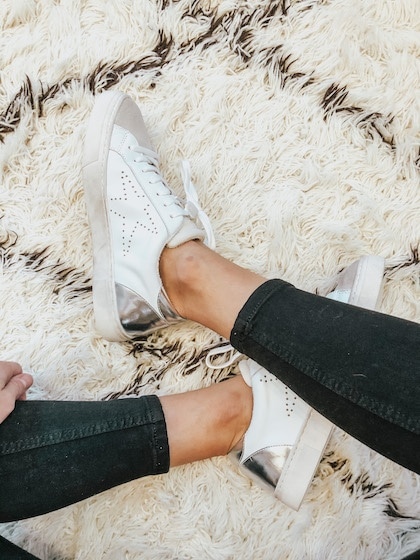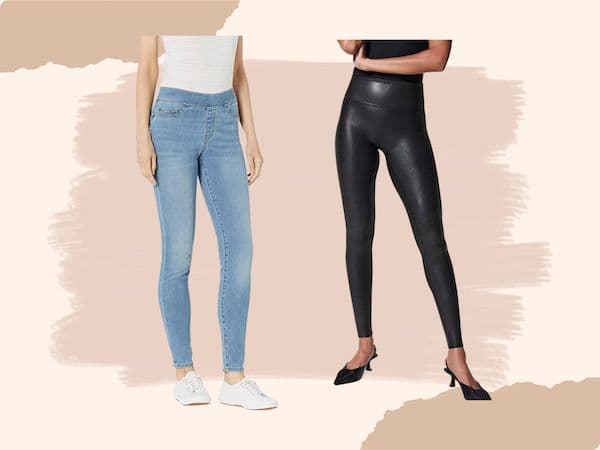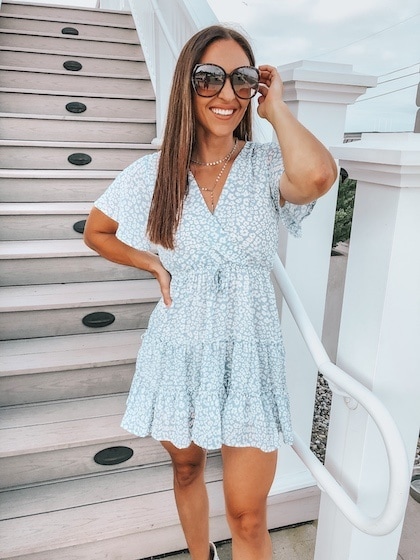How To Properly Measure Your Torso For A Swimsuit
Let’s face it, swimsuit shopping can often be a daunting task.
Not to mention, it can be intimidating and confusing when you don’t know the right swimsuit to pick for your unique shape and size.
In this post, I’ll walk you through the steps to measure your torso length, bust, cup size, band size, waist, and hips, to help ensure you will find a bathing suit that fits perfectly.
We’ll also chat about the best types of swimming suits for various body types and how to best read swimming suit sizing charts.

Taking Body Measurements Correctly
Before we dive into the details of measuring each body part, it’s important to understand the guidelines for taking precise body measurements.
Here are some tips to help you get the most accurate measurements to ensure your suit is comfortable in all the right places.
- Use a flexible measuring tape: A pliable, soft measuring tape is the best tool for taking body measurements since it can easily wrap around your curves. You can also use a piece of string if you don’t have a measuring tape.
- Stand up straight: Maintain a natural, tall posture while measuring to ensure accuracy. Avoid slouching, bending, or twisting.
- Keep the measuring tape snug, but not overly tight: The measuring tape should be snug against your skin without digging in.
Now that we’ve covered the basics, let’s get into the easy steps for measuring your body to ensure you get the right size swimsuit the very first time!
How To Measure Torso Length For A Swimsuit & Other Body Measurements

Measuring Your Torso
The length of your torso and your torso measurement helps determine your overall swimsuit size, especially for a one-piece swimsuit.
Here’s exactly how to measure torso your length for a swimsuit:
Step 1: Stand up straight.
Step 2: Use your measuring tape, start at the mid-point of your shoulder, go down your front, between your legs, and up your back to the starting point. Once again, make sure to keep the tape snug but not too tight.
This will give you your torso length in inches, which you can use when looking at the size charts of many popular brands.
Alternatively, if you want to know whether you have an average, short, or long torso, you can follow the below steps to get a better idea.
Step 1: Put the starting end of the tape measure at the top of your head. Measure from your head down to your groin. This is measurement 1.
Step 2: Starting from your groin, measure down to the floor. This is step 2.
If your measurement is longer in step 1 than it is in step 2, you have a long torso. If your measurement is longer in step 2 than it is in step 1 then you have a short(er) torso.
Keep in mind, many brands make swimming suits specific to individuals who have a long torso or a short torso.

Measuring Your Bust
A significant part of finding the right swimsuit or bikini top involves getting an accurate measurement of the fullest part of your bust. To achieve this, follow these steps:
- Wear a non-padded bra for the most precise measurement.
- Wrap a soft and pliable measuring tape around the fullest part of your chest, ensuring it’s not too tight.

Measuring Your Band Size
Your band size is crucial for a comfy fit, especially with more fitted swimming suits:
- Wrap the measuring tape around your rib cage, just below your bust – where the band of a sports bra would sit. Again, keep the tape snug but not too tight, and record the measurement.
Determining Your Cup Size
Now that you’ve measured your bust and band, you have everything you need to figure out your cup size:
- Find the difference between your bust and band size then use a bra size chart or conversion chart to find your corresponding cup size.
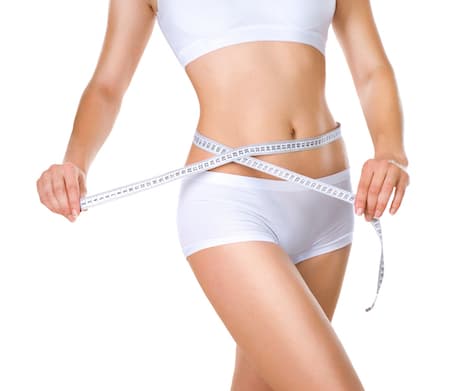
Measuring Your Waist
Your natural waistline is the narrowest point of your torso, usually near your belly button.
- You can find your natural waistline by bending to one side and taking note of the natural indentation.
- Wrap the measuring tape around your waist the record the measurement without holding your breath or sucking in.

Measuring Your Hips
Your hip measurement is vital for finding the perfect swimsuit especially when it comes to bikini or two piece suit bottoms:
- Stand with your feet shoulder width apart and wrap the measuring tape around the fullest part of your low hip and buttocks then record the measurement. Note: It’s important to get around the fullest part of your hips so take your time finding that exact spot.
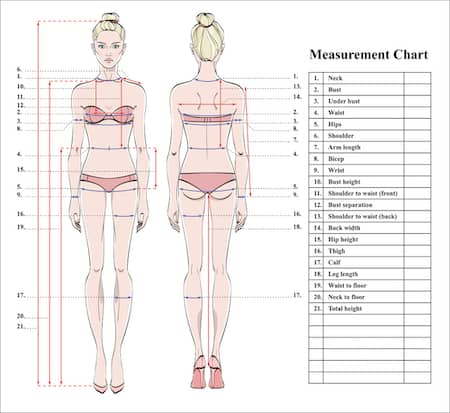
How To Read Swimsuit Sizing Charts
Understanding how to read swimsuit sizing charts is another important part for finding the perfect fit for your swimming suit.
Most online stores and swimwear brands provide sizing charts on their websites, usually under the product description or in a separate “Size Guide” section.
Some brands may also include a fit guide with their swimsuits, which can be found on the product’s packaging or tags.
Swimsuit sizing charts typically feature sections that outline the measurements for the bust, waist, hips, and torso.
In addition, some brands might provide separate measurement charts for different types of swimsuits such as; one-piece suits, bikini tops, and bikini bottoms.
To find the best size for you, simply compare your measurements taken above to the sizing chart provided.
If your measurements fall between two sizes, consider the style and material of the swimsuit before deciding. You might also want to consider looking for an honest review to decipher if the piece runs large or small.
It’s generally better to size up for a more comfortable fit, especially for one-piece swimsuits or swimsuits with less flexible material.

Keep in mind, however, that some brands may use different sizing systems, such as US, UK, or European sizes, so make sure to use the correct conversion chart if necessary.
For swimsuits with built-in bras or specific cup or bra sizes, use the bra size chart provided by the brand to find your ideal fit.
Some brands may also include underbust measurements in their charts, which can help you find the correct size for bikini tops or swimsuits with more support.
Remember that sizing charts are a starting point and may not account for all body types or personal preferences.
Lastly, you’ll want to consider how you want your swimsuit to fit. If you’d like your swimming suit to fit tighter for more support, you may want a smaller size.
Whereas if you’d like your swim attire looser for more comfort or extra coverage, go for a larger size. Take these into account and adjust your size as needed.
Different Body Types
Ok… now that you have your measurements, let’s discuss different body shapes and how they can affect your swimsuit sizing:
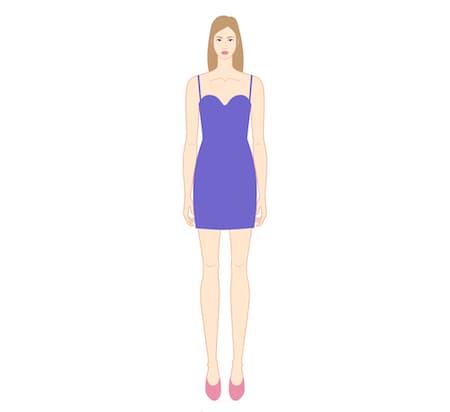
Apple body shape
Apple-shaped bodies have wider shoulders and busts, with a fuller midsection and slimmer hips. Meaning most of the weight is carried in the midsection.
This shape often showcases shapely legs, which can be accentuated with the right swimwear.
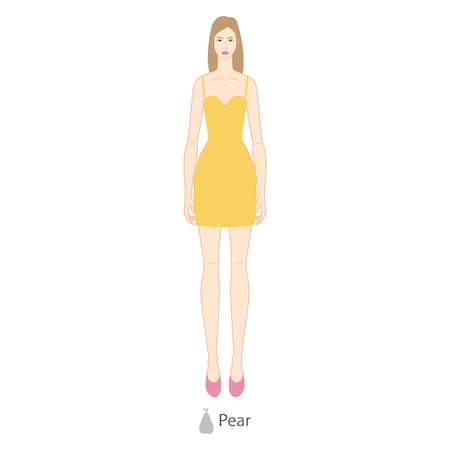
Pear body shape
Pear-shaped bodies have narrower shoulders and a smaller bust compared to wider hips. Meaning most of the weight is carried in the hips and butt.
This shape usually features a well-defined waist, which can be emphasized with the right swimwear choices.
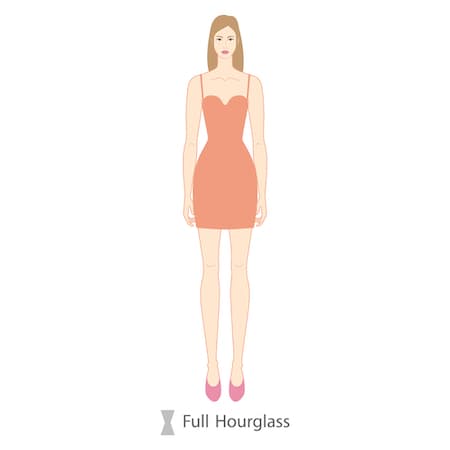
Hourglass body shape
Hourglass figures have balanced bust and hip measurements with a significantly narrower waist. Women with this shape can accentuate their natural curves and waist with swimwear that highlights these features.
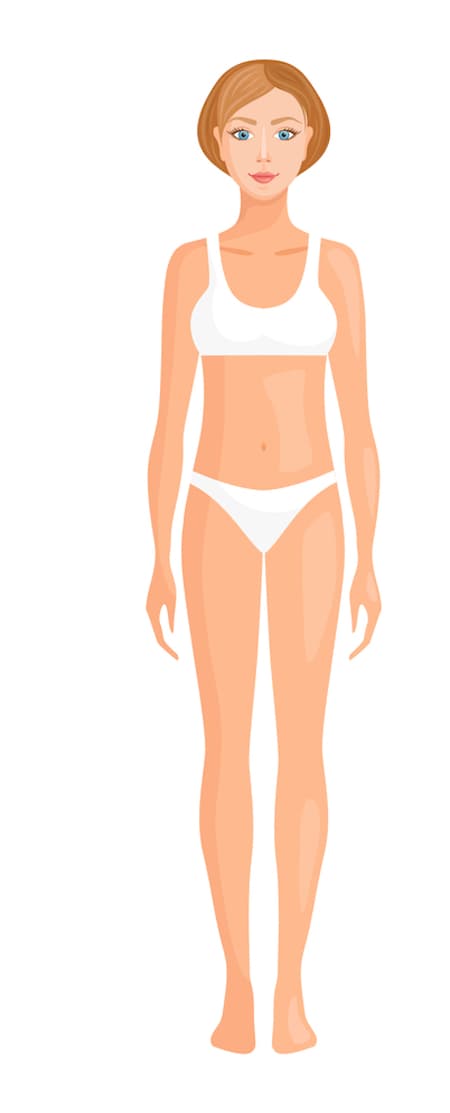
Rectangle body shape
Rectangle or straight body shapes have minimal curves, with the bust, waist, and hips being relatively similar in width. Swimwear with details that create the illusion of curves can be a flattering choice for this body type.

Inverted triangle body shape
Lastly, inverted triangle shapes have broader shoulders and a larger bust compared to slimmer hips.

Long Torso & Short Torso
While a long torso isn’t a “body shape” it is still a significant body proportion that comes into play when shopping for a bathing suit (or any garment for that matter).
Someone with a long torso (typically) has lower hips and shorter legs. Because of this, one-piece swimsuits, bodysuits, and bottoms, in general, can be much harder to shop for as inseams can be too short.
The inseam for an average-length torso will vary greatly from one that is designed specifically for someone with a long torso.
On the flip side, if you have a short torso, you will likely have the opposite issue. Those with a short torso will often find that they have too much fabric in the midsection vs not enough.
Chances are, you already know if you have a short or long torso just by the way your clothes fit. However, if you want to get specifics on just how long or short, you can take measurements as mentioned above.
Shop Plunging One-Piece Bathing Suit | Shop One-Shoulder Bikini | Shop High Waisted Bikini
How to Choose the Right Swimsuit for Your Body Type
While everyone has their own personal style, it’s important to keep your measurements and body shape in mind.
Here are a couple of tips for choosing the best bathing suit for your shape.
- Apple Shape: Swimsuits with ruching or tummy control are great for creating a slimming effect for those with an apple body shape. You may also consider high waisted bottoms and low cut tops to enhance the chest area.
- Pear Shape: High-waisted bikini bottoms or one-piece swimming suits can provide more coverage for the hips. Accessories like wraps, cover ups, or skirts are also great options.
- Hourglass Shape: Swimsuit that have a defined waist, such as a belted one-piece or a two-piece with a high-waisted bottom are a great way to highlight curves with an hourglass shape. Open necklines or v-neck swimming suits also complement an hourglass shape well.
- Rectangle Shape: Bikinis are a great option for those with a rectangle shape. You can even create the illusion of a curvier frame by opting for a suit with ruffles or frills.
- Inverted Triangle Shape: Asymmetrical and plunging or lower necklines are very flattering for those with an inverted triangle shape. You might also consider pairing a bottom with a lot of details with a dark colored top to give the illusion of a smaller chest and shoulder area.
- Longer Torso: High-Waisted bikini styles tend to look best on those with a long torso as they help to create balance. Halter necklines with an adjustable tie and triangle bikini tops help to break up a long midsection while also balancing out a high-waisted bottom. Adjustable straps are also idea to release tension throughout the midsection.
- Short Torso: One-shoulder bikinis, high-cut one-piece suits, and strapless bikini styles all look incredible on those with a short torso.
A swimsuit style with a higher neckline is universally flattering but is especially great for those with larger busts.
Here are a couple more things to consider in regard to colors, patterns, and design elements of the swimwear:
- Use darker colors to minimize areas you want to downplay
- Lighter colors or patterns can be used to draw attention to your favorite features
- Vertical lines and patterns can help to elongate your torso, while horizontal lines will create a more broad look.
- Adjustable ties and straps can be very beneficial for customizing your fit, especially if you have a longer or shorter torso.
Conclusion
And there you have it! With these tips and tricks, you’ll be well on your way to finding a swimsuit with the right fit.
And let’s all try to remember, the key to finding the best fit is not only about understanding your body shape and taking proper measurements but also how it makes you feel and the confidence you exude wearing it!





